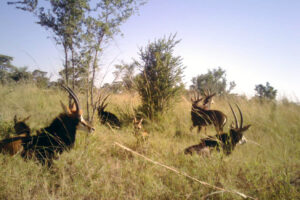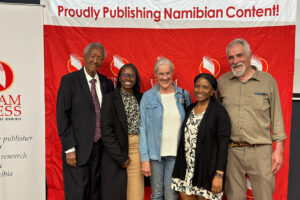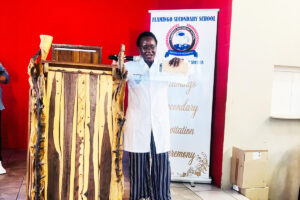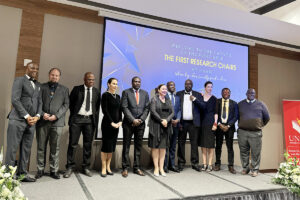The University of Namibia (UNAM) established the Department for Wildlife Management and Tourism Studies (DWTS) in 2012 as part of the Faculty for Agriculture, Engineering and Natural Resources (FAENR), at the Katima Mulilo Campus. It is located close to the national parks in the region giving it a competitive advantage to ensure practical and applied studies and research with minimised transaction costs. The department is located ideally at the heart of the Kavango Zambezi Transfrontier Conservation Area (KAZA TFCA) in an area with high biodiversity, considerable cross-border wildlife movement, and enormous tourism potential required to educate and train professionals in the field of wildlife management, conservation, environment, and tourism. The department offers a full-time BSc (Honours) degree and a part-time MSc degree. As part of this programme, students must be exposed to fieldwork and first-hand practical activities such as wildlife monitoring, wildlife corridor establishment, tourism enterprises, wildlife-based tourism, animal behaviour, ecology, bird watching, observation and survival techniques in the bush, camping ethics, safety, water, and food.

Students should be able to identify different wildlife habitats and develop species checklists of the mammals and birds encountered along the Zambezi River, Sikunga Channel, National Parks and Conservancies. They should be able to engage in field orientation and team building, camping ethics, sounds of the night/aural lion count, general diversity and ecology (Introduction to Biology); examine the different marketing strategies that are influenced by different tourism enterprises; examine the technology, equipment techniques, and wildlife photography. They should further learn the medicinal and other uses of plants at Sangwali by the Mayeyi community, environmental education and awareness. In addition to participating in the annual foot game count conducted by our stakeholders, the Ministry of Environment, Forestry and Tourism and Integrated Rural Development and Nature Conservation (MEFT; IRDNC), bird systematics along the Kwando river, students should also be collecting information on habitat quality and ecological carrying capacity, and visiting the under-construction crocodile Kongola farm. Furthermore students should conduct counts for the lifetable analysis, distribution patterns and interactions, identification of ungulate species, and collect spatial data. This will expose students to extraction protocols (non-invasive versus invasive); setting up and running PCR, PCR machine and programme (e.g. lgd, etc.) protocols; diversity of molecular markers and how to interpret sequences and microsatellites; remote camera trapping, spoor tracking, and point counts (birds) surveying purposes; radio telemetry spatial ecology; and herpetology (Otjiwarongo Crocodile Farm). Students thus get exposed to the art and science of observation, and the identification of faunal wildlife resources. Various techniques will be demonstrated – particular hints and procedures on how to identify birds, for instance. The data on the Bird count gathered along the Kavango River shall contribute to the annual summer census undertaken over the past decade.
Other areas include: Human dimension and management of protected areas (National Parks and Conservancies), National Parks and governance, animal behavior, ecological methods, wildlife conservation, and exotic plant eradication, Tecoma stans, at Livingstone Museum, Kwando River. This was followed by planting two indigenous trees in the area cleared.
Students also look at herpetology, ecotourism, taxidermy, ecology of desert ecosystems and biogeography. Students recently assisted in the verification of wildlife counts at Mahango Core Area, and the data was analysed by them, resulting in the creation of distribution maps.
Field excursion trips typically last at least 24 hours and up to 10 days. Trips include visits to the Zambezi and Kavango regions, the Cheetah Conservation Fund (CCF), Otjiwarongo Crocodile Farm, Etosha National Park, Brandberg Mountain, the Seal Colony at Cape Cross in Dorob National Park, Swakopmund (aquarium and snake park), Walvis Bay Lagoon (one of the world’s RAMSAR sites), Sossussvlei, Dead vlei, Sesriem Canyon, Gobabeb Research and Training Centre, and Waterberg Plateau, etc. The department, for instance, took first and fourth year students on a 5-day excursion to the Mahango Core Area in the Bwabwata National Park on September 20, 2021, which included visits to Popa, Divava, Mahangu Safari Lodge, Dhove Safari Lodge, and Ngepi.

First and fourth year students were treated to a morning wildlife talk as well as practical drone flying training in the Mahango Core Area, which is located on the western side of the Okavango River along the C48 road all the way to the Muhembo border post in Bwabwata National Park. The Mahango is home to approximately 300 bird species and 99 mammalian species.
As part of the ecotourism module, first-year students are introduced to the ecotourism industry at Divava Kavango Lodge and Spa, located in the Bagani area along the Okavango River. Students learned about hospitality as well as the effects of the COVID-19 pandemic on tourism and hospitality businesses.


Arnold Mbaimbai and Tanaka Muradzikwa, both 4th year students, took some incredible photos (showcased here) of a Vervet monkey (Chlorocebus pygerthrus) and a warthog (Phacochoerus aethiopicus) during a Wildlife Photography module excursion. The rest of the photos will be archived at the department, and some will be framed and displayed on the walls of the lecturers’ offices within the department.

Third-year students were taken to CCF, a global leader in cheetah research, conservation, and education. Its centre is 44 kilometers east of Otjiwarongo, where they visited the Genetic Conservation Lab and conduct field experiments. This visit to CCF occurs on an annual basis.
To increase access to remote areas, the department purchased two 4×4 Land Cruisers (1 single cab and 1 double cab), a boat, and two trailers for research and field excursions with KfW funding, and the fleet is expected to arrive very soon. Future plans include purchasing field uniforms for students for field work, excursions, and attachments. Furthermore, exploration of other regions both within and outside of Namibia.
The department would like to express its gratitude to MEFT for providing them with free entrance and camping permits to national parks.





